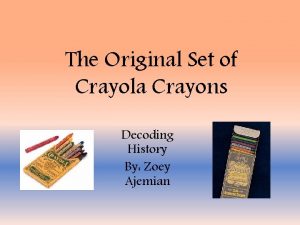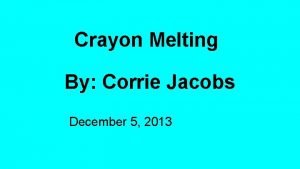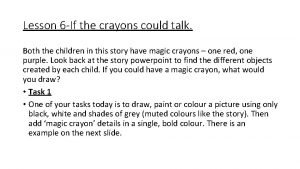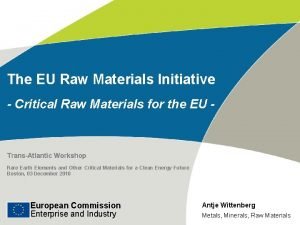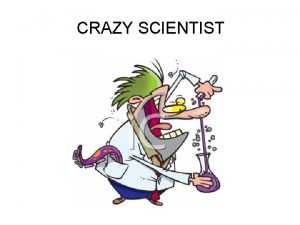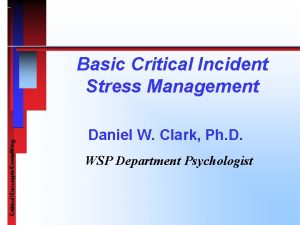Critical Crayons What Does a Materials Scientist Do
















- Slides: 16

Critical Crayons

What Does a Materials Scientist Do? Everything is made of something. For our products to function well, we need to use the best materials.

What’s your cell phone made of? • Glass • Plastic • Copper, Aluminum • Very small amounts of critical metals

Where do metals come from? All metals are mined from the earth

Does the earth continuously make metal? • Metals were imparted to the earth when it was formed billions of years ago. . . • What we have is all we’ve got • Certain metals are abundant (iron, aluminum) • Others are scarce (niobium, vanadium, indium)

Critical Metals • Metals that are very important, but are scarce • Used in cell phones! Also solar panels, TV’s, computers, magnets, lasers, medical technology, fuel cells, motors, fiber optic cables. . • Their supply is not secure • Technology cannot progress without these metals

What do we do?

Recycling • When we throw stuff away, everything gets mixed and we get a useless mess • The mess only becomes useful when we separate the parts • Glass, aluminum, plastic, copper • We separate the parts using differences in properties • Recycling is separation

Difficulties • Once mixed, the parts like to stay mixed due to entropy • You will need to do work for separation • When one material is very dilute, it will be harder to get it out • It’s often impossible to get all the impurities out • The parts are never as good as they were before – downcycling

Design Challenge • Imagine in the future crayon wax is a ‘critical metal’ and is very scarce • Crayons have been thrown away for years and are present in landfills • We have to turn to our trash if we ever want crayons again • I go to the landfill and shred up what I find to recycle them

Design Challenge • Devise a multi-step process (but no hands!) to sort through waste and yield enough shavings to make 1 crayon (about 6 g) • Melt the wax in a foil cup on the hot plate and pour 2 new cool with yield ice water • crayons Iterate to–get a purer - the to speed the curing purer the recycled mixture, the stronger the crayon! • Molten wax may ONLY be used at the hot plate tables – not at your group’s table

Design Challenge • Conduct a 3 -point bend test on the crayons. • Use table-to-table boundary at same height and at least a 1” gap • Use 1 -turn of string over a bucket handle and add water until crayon breaks. Record volume of water for breakage. (Make the string long enough so that the “crash” does not get water everywhere!) • Report results out to larger group!

Design Challenge Hints: • Crayon won’t float in regular water, but will once a certain amount of salt has been added. • You will likely need all sizes of crayon (both flakes and bits) from your mixture to yield enough for 2 crayons (~6 g out of ~12 g in your waste mix) • Pour your measuring water slowly to get an accurate breaking point

Materials • A container with lots of shredded waste including enough crayon shavings to make 2 crayons • Separation Tools (choose 3 max per group at a time) • • • Magnets (ferromagnetic materials? ) Sieves, colanders and slotted spoons (particle size/shape) Water (float? ) Balloons (static? ) Coffee filters

Questions • Does the addition of impurities always make a material weaker? • How did the lab illustrate ‘downcycling’? • If you wanted to scale up your process, could you do it efficiently? (Automate? ) • Is it better if we can sort bigger pieces before shredding? – designing for disassembly

Image Sources • http: //e-wasteregulation. blogspot. com • http: //www. cnet. com/news/iphone-6 -will-adopt-curved-display-claims-latestrumor/ • http: //www. biostockspro. com/7 -advantages-of-precious-metals-investment/ • http: //www. pc 3 mag. com/少年你太年輕了:apple-突然變慢是個陰謀! • http: //www. colourlovers. com/web/blog/2008/04/22/all-120 -crayon-names-colorcodes-and-fun-facts • http: //www. thomasnet. com/articles/electrical-power-generation/NIB-magnetapplication • http: //www. photo-dictionary. com/phrase/2821/sieve. html • http: //www. seprotech. com/company-profile/
 Critical semi critical and non critical instruments
Critical semi critical and non critical instruments Spaulding classification
Spaulding classification Crayola crayons history timeline
Crayola crayons history timeline The day the crayons quit summary
The day the crayons quit summary Hypothesis for melting crayons
Hypothesis for melting crayons How many
How many If crayons could talk
If crayons could talk Mrs evans has 120 crayons
Mrs evans has 120 crayons Belief me
Belief me Slidetodoc.com
Slidetodoc.com Raw materials initiative
Raw materials initiative Cant stop the feeling trolls go noodle
Cant stop the feeling trolls go noodle All household materials are useful
All household materials are useful Natural materials and man made materials
Natural materials and man made materials Differentiate adopting materials and adapting materials
Differentiate adopting materials and adapting materials Direct materials budget with multiple materials
Direct materials budget with multiple materials Food scientists measure food energy in
Food scientists measure food energy in


